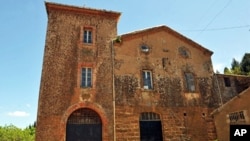A movie about the lives - and gruesome deaths - of French Cistercian Trappist monks in Algeria has become an unexpected box-office hit in France and has now been released worldwide. "Of Gods and Men" is set during Algeria's horrific 1990's civil war. The Tibhirine monastery where the monks live, serves as a reminder of the country's unresolved past.
The French Cistercian monastery sits on a small hill overlooking the Algerian village, Tibhirine, a two-hour drive from the capital. It is a large, rambling stone building surrounded by high walls and fields. The view from here is magnificent - the valley and distant hills spread below.
Fifty-three-year-old Jean-Paul Tissot shows a visitor around. He arrived here from France, last November, to help the Catholic Church care for the monastery.
Tissot says he wants to prepare the way for a new community of monks to move in. He wants to be proof that living at the Tibhirine monastery is possible - although there are no plans for more monks to come here anytime soon.
Fifteen years ago, a community of Cistercian Trappist monks did live at the monastery. They kept bees and farmed.
But in the 1990's, the monks were caught up in Algeria's brutal civil war that pitted Islamist militants against the military-backed government. It killed upwards of 150,000 people. The monks decided to stay. They felt the village needed them.
In March, 1996, seven of the monks were kidnapped. Two months later, they were killed. Their severed heads were found, but not their bodies. Only two monks, who had been hiding in the monastery, survived.
A movie about the monks has become a box office hit in France. "Of Gods and Men" won the country's prestigious Cesar award for best movie, last year. It is now being released in other countries.
Tissot shows the monks' gravestones. They are located in a beautiful, peaceful spot, surrounded by pine trees.
Tissot has not yet seen the movie. Right now, he feels too close to the events.
Tibhirine has not forgotten the monks. Village resident Samir Lahmani says the monastery completed their lives.
Lahmani says the monks were good to the village. They gave money to the poor. One monk, Father Luc, was a doctor who cared for the sick.
It is still unclear who killed the monks. Was it the Islamist terrorists? Or was it, as some suggest, the Algerian army, because the monks refused their demands to leave?
The question of who killed who during the bloody 1990's still haunts Algeria. Some, like Nassera Dustour, have made it their life mission to find out the truth. Dustour is spokeswoman for SOS Disparus, an association representing the families of an estimated 8,000 Algerians who disappeared during the civil war. That includes her son - who would have been 35 years old today.
Dustour says the Algerian state must investigate the massacres. The killers must be given names. The country must confront its past.
What is clear is that the monks have left a profound mark in this Islamic country. Visitors from all over Algeria drop by. Tissot gives them a tour of the monastery. Some have read about the monks in the newspapers or heard about them from friends.
Faiza Ahfir, who drove here from the coastal town, Tipaza, downloaded the movie "Of Gods and Men" from the Internet.
Ahfir says her family was deeply moved by the film. She says the monks could have left the violence and returned to France. Instead, they chose to stay.
Should Algerians forget their past? Bury what people here call "the black decade?"
No, Ahfir says, absolutely not. Algerians have experienced it all - civil war, terrorism. She says now they must draw lessons from it.








